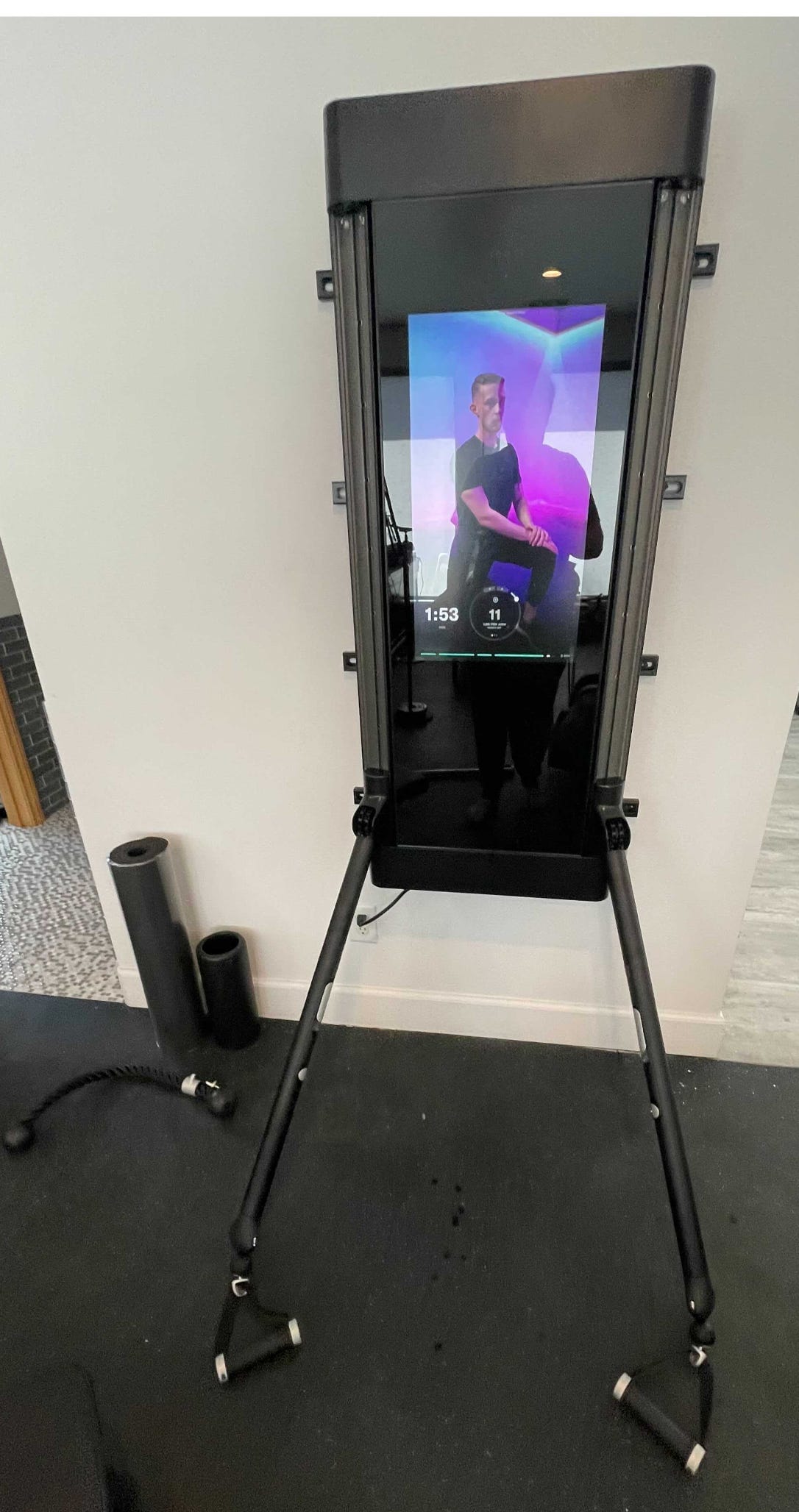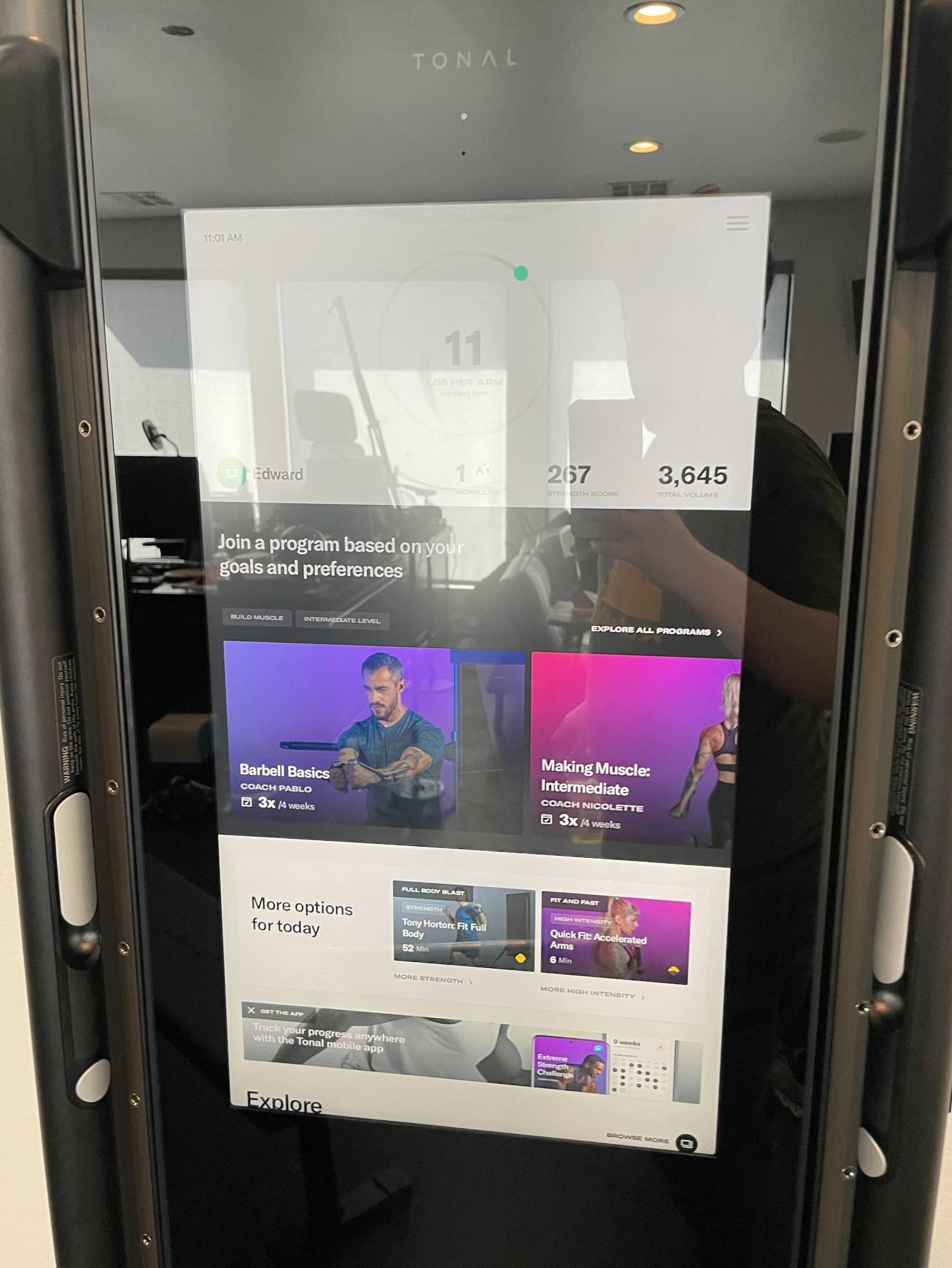This week ends with probably the least likely thing to happen to me - a vacation. The wife and I are taking a few days off to relax (no, I am not getting on a plane, at least until I’m fully vaccinated), which will mark my first vacation time I’ve taken since…2019? It won’t be activity-filled, but both of us desperately need it (her especially). It’ll be really nice. It also means I will likely not write anything Thursday or Friday, because I’ll be too busy sleeping and doing other stuff people allegedly do to relax.
Either way I look forward to not setting an alarm and watching every single episode of the show Preacher while eating wings. That’s about it.
Tonal, The Robot Gym
Today my Tonal arrived, and I am astounded by it. It’s going to get the obvious treatment of “it’s like Peloton for weights!” because it, well, is Peloton for weights. It’s a big screen with guided classes that also connects to two adjustable arms, using magnetic resistance to control the weight on each one. accessories attach to it using a little t-lock, and classes are displayed on the screen. You get a barbell, a pair of handles, a weight rope and a mat.
Crucially, it also tracks your progress, and automatically adjusts your weights so that you progress naturally. There’s an initial class that I foolishly thought would not be a “real” workout (it was) that helps set the right weights for the system to start on, and then each class it monitors your progress and pushes you. So, each class you’re not having to set weights, or count reps, or really do anything other than show up.
It rocks. I have wanted something like this since the first time I ever lifted a single weight back when I was a teenager. My dyspraxia means that fiddling with apps and notes to remember stuff is draining mentally, and I need guidance - I need to know what I’m doing, I need to know when I’m getting stronger, and I need a lot of that done for me.
“Get a personal trainer Ed!” - hey, what’re you doing in here, I didn’t let you in my house! But also I tend to work out when I can based on the day’s calls and activities. I have a coach for my bike who precisely organizes my classes, but I am early on enough in lifting that what I need is guidance and consistency.
How It Works
The Tonal is mounted to your wall (specifically they need the right studs, which is why mine is somewhat to the right) by the delivery team. These things are sold out for months - I ordered mine mid-December 2020, and it arrived today (March 15 2021) - because they’re basically making them as they get orders in. It also makes sense because the thing is huge, and incredibly well-made. I’d say the build quality is a lot like Peloton - big, chunky pieces of metal that don’t feel like they’ll snap.
A sidenote: I don’t know if there are live classes. This is not something I care about and I do not know why you do. I also know there’re social things and I don’t care about them either. There’re achievements and badges and metrics and that’s cool, and that’s what keeps me going.

Without going into some extremely long product review thing, you choose a class on Tonal on the touchscreen and start it and they guide you through workouts. You adjust the arms using a few buttons on the sides, which either let you turn them or lift/lower them to fit an exercise.

A crucial detail to know is that while these are guided classes, you can actually pause them, unlike Peloton. Also crucially, the classes pause when you need to adjust the arms and will not progress until you finish the reps. This was a core anxiety I had about the machine - that I’d be in a class where Tony Horton yelled at me to start doing something and I’d be too slow, and end up getting frustrated and sad and throwing it in the trash.
Another feature I love is that the buttons on the sides of both the smart handles and a little button on the barbell that engages or disengages the weight, so that you don’t have to set up with weights on you. The machine measures your reps, and based on the speed of particular movements will (specific to each rep) - my goblet squats apparently around rep 6 start speeding up - which is cool and makes you better.
Technically it seems like it’s just a big android tablet with arms attached, but what they’ve pulled off with software is fantastic. You can also create your own workouts that just automatically load on the machine, which is great, and if you don’t want to let the AI choose you can set your own weights too. I am a little baby with tiny baby arms so mine is lower than what yours would be.
A nice touch is also that the arms tell you where to put them depending on the exercise, which removes my personal anxiety about getting them in the right spot. It’s really good! It works really well.
There’re also different forms of resistance - a spotter that can lower the weight dynamically if you’re struggling, eccentric mode that adds resistance on the negative portion of a movement, and chains that adapt to get heavier on pulls/pushes. These are super weird at first but I love them.
Also, you can now pump your Apple Music into it, which is really cool. Newer classes let you control the volume of the instructor over the music too. It rocks.
The Bowflex Conundrum
One of the more trite jokes people made about Peloton that they will absolutely make about this is that it’s like the Bowflex, in that it will be doomed to be used once then never used again. Having been someone who actually bought and then proceeded to not use their Bowflex (and thankfully was able to sell it at cost), I think people genuinely do not realize why people don’t use exercise equipment.
Generally, what gnaws at someone’s ability to do any particular task isn’t simply the difficulty of said task, but the difficulty of beginning and completing said task. Theoretically, you could just get two adjustable dumbbells and read everything off of Youtube or Google, but that will involve you constantly readjusting weights, working out your own routines and on some level guessing how to grow and change things up. Every single one of Bowflex’s products (though this applies to most home gyms) are just a little too fiddly, and while you’ve got guides of what to do, you still have to adjust, you still have to work out how to get stronger and what stronger looks like, you still need to do all of these things.
All of which is fine when you’re in a good mood, and feeling mentally good, on a good day for working out. But when you hit your first annoying day - you’re tired, work’s tough, lots on your mind, etc. - it becomes a lot more of a lift to do all of these little pieces of effort to reach one larger goal. This is why people get personal trainers - people who do a lot of this busywork for them - but having one of those requires going to a gym, and you bought a gym for the home.
Peloton took off because cycling is generally pretty easy-going on you regardless of weight, but also because you are guided by the hand throughout an entire class, and you are physically clipped in so the chance of you “doing it wrong” is much lower. You have clear-set metrics to follow, it’s fun, and it’s a great cardio workout. Your metrics are saved, you can see yourself getting stronger, it makes sense.
What the elder fitness companies missed is that it’s not just about everything being in one place, it’s that the mental work of getting to the gym and doing stuff is taken away. NordicTrack’s weirdo home gym thing comes with a tablet that shows you classes, but doesn’t seem to capture weights and feels like it’s more about offering 4 million different ways to work out than 50 good ones.
I think that a lot of the past failings of the fitness industry to create enduring home gym products have been around a misunderstanding of how people work out and why people don’t work out. The assumption on their part was that people don’t work out because it’s tough going to the gym, or that people don’t work out because there aren’t options or guides. The reason is that when you are not actively guided with numbers that you can see go up or down, with a clear beginning and end and a continuum of exercise that builds to something, fitness becomes incredibly depressing.
“Wanting to get thinner” and “wanting to get toned” are both lofty and vague. Progression is almost entirely focused on the scale or your clothes, which means until that happens you’re just doing stuff. Without hard numbers and structure, it becomes a lot harder to motivate yourself to keep going, and by creating fitness experiences that are heavily based in tangible, approachable numbers, you’re giving people a lot more carrot to go with their stick.
Feeling Like The Future
This specifically feels like I’m living in the future. One of my core issues with Peloton is that there is very little personalization to any riding - you set power zones with an FTP test, and then follow the zone number that the instructor calls and then ride that until they say otherwise. Frankly, and I say this as someone approaching 850 rides, I feel like Peloton has an incredibly weak user experience, and despite being a multi-billion dollar company they have managed to do very little to change it - live classes are live classes, you can now (as of last week) plan a ride with some friends and ride together), and now there’s a bike that can turn its screen so you can do some free weights during a class. If I didn’t have my coach telling me what to ride every week, I do not know if I’d ride as consistently.
Specifically, Peloton doesn’t seem to do anything with your ride data. Other than Power Zones which are based on your threshold test, Peloton doesn’t seem to actually customize itself to you other than saying you might like a particular class, which is crazy, and perhaps a symptom of a growing userbase that will clap like a seal for basically anything.
Tonal feels more futuristic partly because of the mode of exercise. Where Peloton is fairly static (any adjustments to weight or output are on you), Tonal is continually trying to coach you through increased weights and different exercises, as well as logging and giving advice about your reps. It does the work of telling you how much to do and locking in weights for you, and you just do the work while using it. It saves your weights, your reps, your routines, anything you’re doing, and knows what to push you to do next. It’s wild.
It also just like…works. It is borderline frictionless. You walk up and work out. I know some purist types will say it’s not enough weight for them, because they want to use barbells and free weights and whatever it is, and that’s fine. I’d argue most people are going to be able to get muscly with this because it’s got all the means to do so. It can do 100lb per arm, and if I reach a point when I hit that, I’ll just do more reps. That’s fine. Doesn’t bother me.
Perhaps this is a bit of a wild assumption, but I can imagine in 10 years something that will dominate hotel gyms. I can’t imagine there’s a way to do it with olympic lifts or serious barbell exercises, but eventually one of these will somehow be a smith machine. It makes sense - you have time-limited and well-guided exercises with easy-to-clean accessories, built for drop-in visits. Peloton is weird in gyms - toe cages for your running shoes feel awkward, and bringing your own clip-on shoes kinda sucks - but Tonal is custom-built for quick hits. And there’s got to be a point in the future where they let content creators and private coaches use the product - it just makes sense.
It’s expensive, though. $3500 with a $49-a-month membership is a lot. You have to know you’ll use it, or be ready to return it in 30 days. All of these home fitness machines have some sort of 0% interest plan for payment, but they’re not accessible, especially considering the 3+ month wait for them. Peloton took years to bring the price of the bike down (and it’s still $1895!), and at $2495 you had better be using the weird twisty screen and auto-resistance on it all the time.
There is likely a very long conversation to be had around the future of technology and class - it’s always been the case that those who are rich can simply pay to be healthier, but the availability of technology-led exercise could help, but at this point simply helps bolster that wall.
Anyway, I’m really excited about this thing. Let me know if you have any questions.


